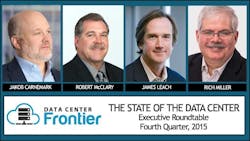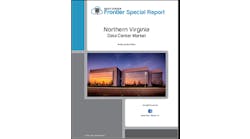Welcome to our second Data Center Executive Roundtable, a quarterly feature showcasing the insights of thought leaders on the state of the data center industry, and where it is headed. In our Year-End 2015 roundtable, we will examine four topics: key industry trends for 2016, energy efficiency trends at hyperscale and multi-tenant data centers, the blurring boundaries between the retail colo and wholesale data center models, and progress on aisle containment in data center cooling.
Here’s a look at our distinguished panel:
- Jakob Carnemark, the founder and CEO of Aligned Data Centers, the first pay-for-use data center provider to offer consumption-based pricing. Prior to Aligned Energy, Jake worked for 11 years as the Senior Vice President of Skanska’s Mission Critical Center of Excellence where he was responsible for growing the international construction firm’s mission critical business.
- James Leach, the Vice President of Marketing at RagingWire Data Centers. As a marketing executive, sales leader, and systems engineer, James Leach has enjoyed a 30-year career building technology and services businesses for commercial and government organizations. For the last 15 years, Mr. Leach has been at the forefront of developing innovative internet services for enterprises.
- Robert McClary, Senior Vice President and General Manager for FORTRUST, a premier data center services provider and colocation facility. Robert is responsible for the overall supervision of business operations, high-profile construction and strategic technical direction for FORTRUST.
The conversation is moderated by Rich Miller, the founder and editor of Data Center Frontier. Each day this week we will present a Q&A with these executives on one of our key topics. We begin our discussion by looking at the year ahead:
Key Industry Trends for 2016
Data Center Frontier: What will be the key trends that will shape the data center industry in 2016?
James Leach, RagingWire Data Centers: There are a number of key trends:
Internet and Enterprise Applications – The Double Edged Sword: We are seeing the convergence of two forces – Internet apps and enterprise applications – into a double edged sword that will drive the data center industry in 2016. Anyone with a smartphone probably uses internet apps every day. These apps are personalized, user-driven, and often have a useful life measured in days or months.
Enterprise applications are the foundation of the Fortune 1000. These applications and systems are corporate, process-oriented, and have a lifespan of years or decades.
James Leach, RagingWire Data Centers
The data center industry in 2016 needs to support both internet apps and enterprise applications. The result will be data centers that deliver scalable power and cooling, flexible space configurations, sophisticated telecommunications and multi-cloud connectivity, and geographic diversity.
The business case for colo is getting stronger. There has never been a better time to be a buyer or supplier of data center colocation.
For colocation buyers, they have access to a wide range of products from a critical mass of established suppliers that promotes fair pricing and superior service. The key is to understand your requirements and timelines so that you have the data center capacity you need, when you need it. Customers are incented to consider colocation as an alternative to traditional data centers because they can get a better product at a lower price than they could build themselves.
For colocation suppliers, capital is relatively accessible to established providers at fairly attractive rates. This capital supports business growth and creates a barrier to entry for new competitors. In addition, the colocation product is maturing which leads to predictable returns on investment. The key for colo suppliers is to match supply with demand. The strategic question is whether to grow your colo business vertically by providing managed services and cloud, or horizontally by opening new locations.
Some analysts will say that cloud computing is the biggest risk to the colocation market. In fact, the opposite is true. Cloud computing providers are some of the biggest and best customers for colocation companies. Also, cloud computing is a great incubator for future colo customers. You start your business in the cloud and grow your business in a data center. Lastly, cloud computing has become a value-added feature to colo. Many colo providers are now delivering direct connections to the top cloud services such as Amazon Web Services (AWS), Microsoft Azure, Google, and IBM Softlayer, as well as the many specialized or verticalized cloud providers such as DreamHost, Dimension Data, Joyent, ProfitBricks, Datapipe, and Virtustream.[clickToTweet tweet=”Jim Leach: There has never been a better time to be a buyer or supplier of data center colocation.” quote=”Jim Leach: There has never been a better time to be a buyer or supplier of data center colocation.”]
Colo Telecommunications Matters: In “Old Colo” the number one telecommunications debate was about carrier neutrality. Most colo customers preferred a carrier neutral environment with local access to dozens of telco providers. “New Colo” retains carrier neutrality and adds multi-cloud access and fiber connectivity. Multi-cloud access from your colo provider is a catalyst to deploying a hybrid strategy that leverages the best of private and public clouds. Fiber connectivity between data centers enables work load balancing, disaster recovery, and application performance optimization.
You’ll hear less about DCIM… The 15-minutes of fame for DCIM is winding down. In 2016, DCIM will become table stakes for colocation providers. DCIM will evolve from collecting and analyzing data to using that data to predict performance and prescribe operations. The result is colo providers will use DCIM to run their data centers at the highest levels of efficiency. Colo customers will plug into the colo DCIM data stream using APIs so they can optimize their individual power usage and provide an end-to-end view of their computing environment.
You’ll hear more about IoT (Internet of Things)…The Internet of Things (IoT) is happening now. The volume, velocity, and variety of data is increasing dramatically. Yahoo and Google were founded in the mid-1990s to organize the world’s information and make it accessible. Facebook, Twitter and the iPhone were launched in the mid-2000s bringing about mobility and social media. The next wave of innovation will be in data, drawing new insights from the Internet of everything.
Robert McClary, FORTRUST
Robert McClary, FORTRUST: The growth of existing data centers and construction of new data centers is a trend that will continue to accelerate. Energy efficiency will always be a trend that will shape data centers, but what will become increasingly more important is efficiency in the way we design and build data centers.
It won’t be just be a matter of how efficiently the data center operates, but how efficiently it is designed and built from a capital perspective. Capital efficiency will be a trend that shapes the data center industry in 2016.
Another thing that will shape the data center industry, which is rapidly expanding worldwide, is an increased emphasis on how we manage and operate data centers, both at the enterprise and the multi-tenant data center levels. The focus on data center reliability is a trend that is here to stay. End-users are demanding reliability and risk mitigation along with lower costs, so you have to be able to design and build reliable data centers that are also efficiently operable. Understanding long term operations in a data center has to get implemented at the design phase of construction.
Jakob Carnemark, Aligned Data Centers
Jakob Carnemark, Aligned Data Centers: The data center industry will continue to be shaped by the underlying market force – the commoditization of compute. With public cloud costs as proxy for that commodity cost, many companies will have to become more adept at benchmarking and identifying the underlying inefficiencies in their organizations.
The network and the data center continue to be barriers to efficient and agile IT, as server and software vendors have delivered on more efficient deployment models.
Network and data center solutions that can solve for greater reliability and agility while removing the significant overprovisioning waste in the current models will become go-to tools for companies seeking solve for the lowest cost of compute.
NEXT: Energy Efficiency Trends at Hyperscale and Multi-Tenant Data Centers
Keep pace with the fact-moving world of data centers and cloud computing by following us on Twitter and Facebook, connecting with me on LinkedIn, and signing up for our weekly newspaper using the form below:








